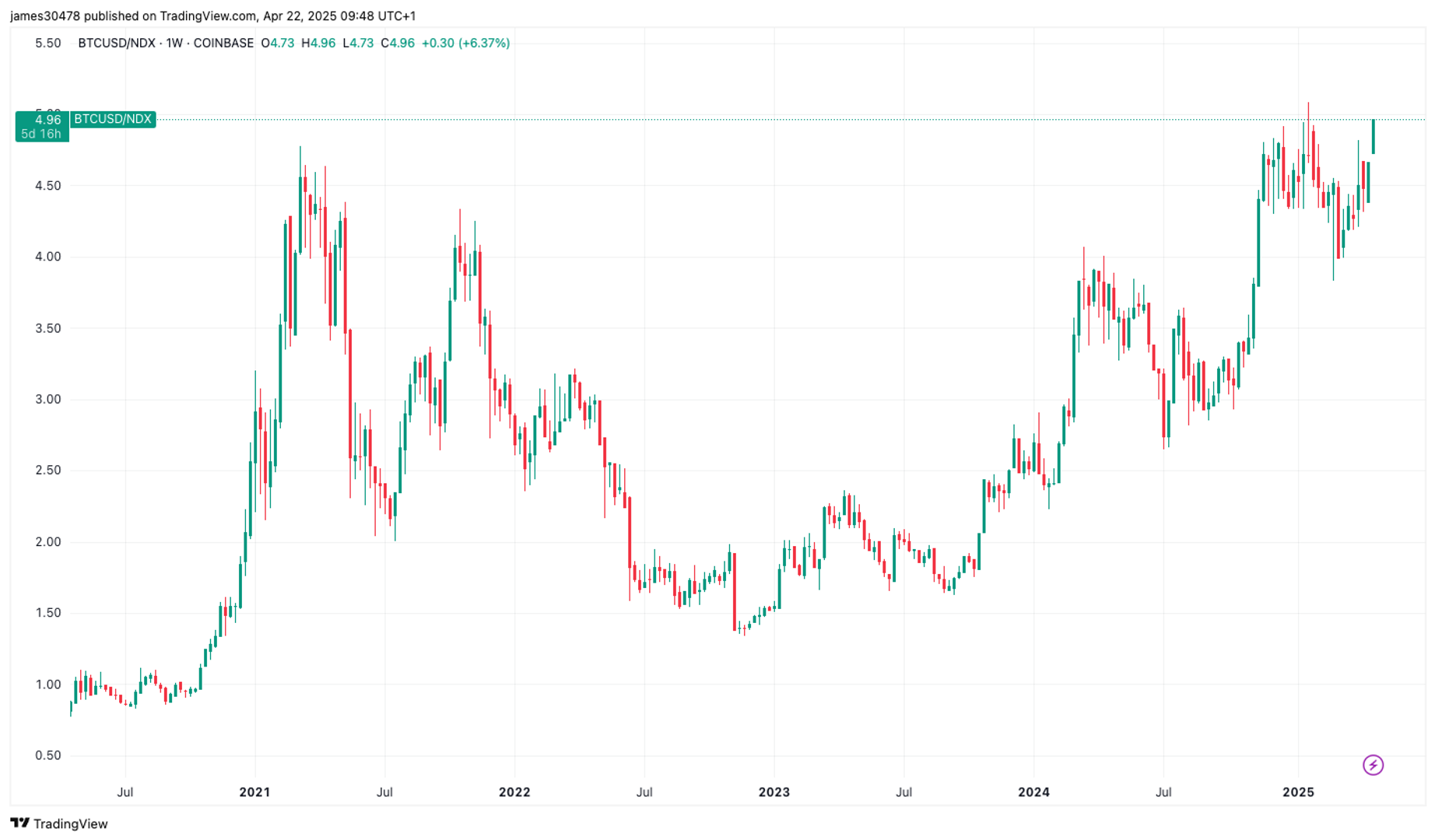Uncategorized
How Aggregation and Decentralized AI Will Completely Reshape Blockchains in 2025

The blockchain industry is on the brink of a major transformation, and 2025 will be the year everything truly starts to shift. But before we get there, it’s important to understand what’s been holding this technological revolution back.
The current, traditional internet works because its infrastructure is scalable and connects users effortlessly, no matter where these users are located. The decentralized ecosystem, on the other hand, still struggles with issues stemming from fragmented liquidity and a clunky user experience that prevent the technology from reaching its true potential.
For this new paradigm to truly become the «internet of value,» it needs to match the current internet’s scalability and seamless connections. The good news? Major breakthroughs are on the horizon. Innovations like aggregation layers and decentralized AI are poised to solve these issues and unlock the technology’s real potential, making it more efficient, intuitive and accessible for everyone.
2 key things the ‘Internet of Value’ needs
To understand why 2025 will be a game-changer, let’s first break down what makes the existing digital infrastructure work: scalability and seamless connectivity. Any user can launch an app or website anywhere, and no matter where that user is located in the world — you’re still just “online,” without needing to connect to any specific local network. This connectivity and scalability are what make our current digital world function so smoothly.
The decentralized landscape, however, still has a long way to go. For Web3 to truly become the «internet of value,» it needs the same two things: endless scalability and unified liquidity. Once we achieve those, a lot of the current barriers disappear. Developers will be able to build their own blockchains without worrying about liquidity or being stuck in isolated ecosystems. Financial apps will be able to tap into massive liquidity pools, and users won’t have to deal with bridging assets. Artists will be able to create their own NFT platforms while still connecting to wider communities.
The biggest change, however, will be the user experience. Right now, navigating Web3 is confusing — cross-chain bridges and slow transfers are a hassle. But once these changes are made, using Web3 will be as easy as using Web2, where everything flows together seamlessly.
The age of aggregation
One of the biggest breakthroughs coming in 2025 is aggregation layer technology. Think of it as the TCP/IP of the decentralized infrastructure, serving as the protocol that connects different networks. Before TCP/IP, the internet was fragmented and clunky, with each network needing custom gateways to communicate with the next. It was slow, error-prone and complicated to use. With aggregation layers, that all changes. By 2025, thousands of blockchains will be linked, but each will maintain its independence while seamlessly sharing liquidity.
Cross-chain transactions will be nearly instant, and users won’t even have to think about how it all works. Just like people do not need to know how the internet works when you browse the web, so will they not have to worry about which particular blockchain they are using to conduct transactions. This will allow distributed networks to connect and scale endlessly while keeping liquidity unified across the entire ecosystem.
AI moves from centralized to open protocols
Another big change coming in 2025 is the shift in AI development. Right now, AI is controlled by a few big tech companies, which limits access and innovation. In 2025, the digital landscape will see decentralized AI become a reality, powered by protocols that ensure fair compensation for those who help develop AI models. This will open up AI development to the community, creating more collaborative open-source frameworks.
Just like aggregation layers will connect blockchains, decentralized AI will break down corporate walls and let AI agents work together across the ecosystem. This shift aligns with the core values of Web3 — shared ownership, transparency and decentralization. Users will have more control over their data, and AI development will become a community-driven effort, free from the monopolistic grip of Big Tech. Blockchain-native AI will also make it easier to automate complex DeFi transactions, optimize gas fees and manage multi-signature accounts with less effort.
Capital will flow like information
DeFi still suffers from fragmented liquidity, making it hard to move assets between different chains. Right now, if a user wants to use assets from one chain on another, that user has to deal with bridges and delays, making the experience far from seamless. But with unified liquidity, that will change. Imagine a situation where if a user had 100 USDT on any network in the decentralized ecosystem, that would be equivalent to having 100 USDT on all chains, instantly accessible with no need for bridging.
Cross-chain transactions will happen almost instantly, and atomic transaction bundles will let users process multiple transactions across chains in one go. DeFi protocols will be able to tap into liquidity across the entire ecosystem, rather than just within their own network pools. These changes will make DeFi much more efficient and create an “Internet of Value” that works as smoothly as today’s “Internet of Information.” Paired with decentralized AI, DeFi will finally deliver on its promise of financial freedom for everyone, without the complexity and exclusion that still plagues traditional finance.
The year that changes everything
The combination of aggregation, decentralized AI, and seamless DeFi protocols is not just about new technology but rather focuses on solving the core problems that have kept Web3 from achieving its real-world potential. In 2025, users will interact with decentralized apps without worrying about the complex tech behind them. Developers will have the freedom to build on any chain while tapping into unified liquidity, and AI will shift to community-driven models. As a result, the whole ecosystem will become more intuitive and accessible to everyday users, finally bridging the gap to mainstream adoption.
Web3 will scale infinitely, while offering the smooth, connected experience that today’s internet users expect. The foundation is already being laid: the first aggregation layers are live, decentralized AI frameworks are being tested and DeFi protocols are evolving for cross-chain composability and AI integration. Together, these changes are set to fundamentally redefine what decentralized technology can achieve.
Uncategorized
Bitcoin Closing In on Historic Breakout vs Nasdaq

Bitcoin (BTC) is on the cusp of breaking out relative to the Nasdaq 100 Composite, with the current BTC/Nasdaq ratio sitting at 4.96. This means it now takes nearly five Nasdaq units to match the value of one bitcoin. The previous record of 5.08 was set in January 2025, when bitcoin hit its all-time high of over $109,000.
Historically, each market cycle has seen the ratio reach new highs—2017, 2021, and now 2025—highlighting bitcoin’s continued outperformance against the Nasdaq.
Across multiple timeframes, bitcoin is increasingly diverging from U.S. tech stocks. Year-to-date, bitcoin is down just 6%, compared to the Nasdaq’s 15% decline. Since Donald Trump’s election victory in November 2024, bitcoin has rallied 30%, while the Nasdaq has fallen 12%.
When measured against the «Magnificent Seven» mega-cap tech stocks, bitcoin remains around 20% below its all-time high from February this year. This indicates that while bitcoin has shown strength, the top tech names are holding up better than the broader Nasdaq Composite.
Strategy (MSTR), a well-known proxy for bitcoin exposure, is also holding up better than the U.S tech stocks. Since joining the QQQ ETF on Dec. 23, MSTR is down 11%, while the ETF itself has dropped over 16%. The divergence has become more pronounced in 2025: MSTR is up 6% year-to-date, compared to QQQ’s 15% decline.
Uncategorized
Bitcoin Runs Into Resistance Cluster Above $88K. What Next?

This is a daily technical analysis by CoinDesk analyst and Chartered Market Technician Omkar Godbole.
Bitcoin’s (BTC) bullish advance has encountered a resistance zone above $88,000, marked by crucial levels that could make or break the ongoing recovery rally.
The resistance cluster’s first and perhaps most critical level is the 200-day simple moving average (SMA) at $88,356. The SMA is widely regarded as a key indicator of long-term momentum. Early this month, Coinbase institutional analysts called the downside break of the 200-day SMA in March a sign of the onset of a potential crypto winter.
So, a fresh move above the 200-day SMA could be taken to represent a renewed bullish shift in momentum.
Such a move would trigger a dual breakout, as the Ichimoku cloud’s upper end is located close to the 200-day SMA. A move above the Ichimoku cloud is also said to reflect a bullish shift in momentum.
Developed by a Japanese journalist in the 1960s, the Ichimoku cloud is a technical analysis indicator that offers a comprehensive view of market momentum, support, and resistance levels. The indicator comprises five lines: Leading Span A, Leading Span B, Conversion Line or Tenkan-Sen (T), Base Line or Kijun-Sen (K) and a lagging closing price line. The difference between Leading Span A and B forms the Ichimoku Cloud.
The third and final level forming the resistance cluster is the high of $88,804 on March 24, from where the market turned lower and fell back to $75,000.

A make-or-break resistance zone?
Behavioural aspects of trading come into play when an asset approaches a resistance zone, especially at key levels like the 200-day SMA and the Ichimoku cloud.
Prospect theory suggests that people are typically risk-averse with respect to gains and risk-seeking with respect to losses, known as the “reflection effect.» So, as traders, people tend to be risk-averse while locking in profits and keep losing trades open.
This tendency is amplified when an asset encounters a significant resistance zone. Traders who entered the bitcoin market around $75K, anticipating a rebound, may feel pressured to take profits as the price approaches this resistance. Such selling could, in turn, slow the price ascent or even trigger a new downturn.
Conversely, if bitcoin successfully breaks through the resistance zone, the fear of missing out could prompt more traders to make bullish bets, further fueling bullish momentum and pushing the price higher.
Uncategorized
Bithumb to Split in Two as Crypto Exchange Inches Toward South Korean IPO

Bithumb plans to split its core crypto exchange business from other activities as it reorganizes in preparation for an initial public offering (IPO).
The Seoul-based company will split in two, with Bithumb Korea focusing solely on operating the core crypto exchange business. Bithumb Korea will be the entity seeking a public listing, local media reported, citing the country’s corporate registry.
The other unit, a newly created company called Bithumb A, will oversee venture investments, asset management and new business initiatives. The restructuring is set to take effect on July 31.
Bithumb A will consolidate the exchange’s investment arms, including Bithumb Partners, which has shifted from NFT and metaverse projects to financial product investments such as equities, bonds and convertible bonds. According to local media, Bithumb is in talks with licensed entities to offer these services in the country.
Bithumb Investment, which manages equity stakes and strategic partnerships with external companies, will also fall under Bithumb A’s oversight.
Last year Bithumb was said to be considering a NASDAQ listing, but now its plans have shifted to a listing on South Korea’s Kosdaq first, with a U.S. listing as a secondary objective.
Bithumb posted an operating profit of 130.8 billion won ($95 million) in 2024, reversing a 149 billion-won loss from the previous year, local media reported.
-

 Fashion6 месяцев ago
Fashion6 месяцев agoThese \’90s fashion trends are making a comeback in 2017
-

 Entertainment6 месяцев ago
Entertainment6 месяцев agoThe final 6 \’Game of Thrones\’ episodes might feel like a full season
-

 Fashion6 месяцев ago
Fashion6 месяцев agoAccording to Dior Couture, this taboo fashion accessory is back
-

 Entertainment6 месяцев ago
Entertainment6 месяцев agoThe old and New Edition cast comes together to perform
-

 Sports6 месяцев ago
Sports6 месяцев agoPhillies\’ Aaron Altherr makes mind-boggling barehanded play
-

 Business6 месяцев ago
Business6 месяцев agoUber and Lyft are finally available in all of New York State
-

 Entertainment6 месяцев ago
Entertainment6 месяцев agoDisney\’s live-action Aladdin finally finds its stars
-

 Sports6 месяцев ago
Sports6 месяцев agoSteph Curry finally got the contract he deserves from the Warriors





